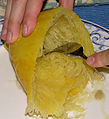
Cucurbita is a genus of herbaceous fruits in the gourd family, Cucurbitaceae, native to the Andes and Mesoamerica. Five edible species are grown and consumed for their flesh and seeds. They are variously known as squash, pumpkin, or gourd, depending on species, variety, and local parlance. Other kinds of gourd, also called bottle-gourds, are native to Africa and belong to the genus Lagenaria, which is in the same family and subfamily as Cucurbita, but in a different tribe. These other gourds are used as utensils or vessels, and their young fruits are eaten much like those of the Cucurbita species.

Acorn squash, also called pepper squash or Des Moines squash, is a winter squash with distinctive longitudinal ridges on its exterior and sweet, yellow-orange flesh inside. Although considered a winter squash, acorn squash belongs to the same species as all summer squashes.

Cucurbita pepo is a cultivated plant of the genus Cucurbita. It yields varieties of winter squash and pumpkin, but the most widespread varieties belong to the subspecies Cucurbita pepo subsp. pepo, called summer squash.

The zucchini, courgette or baby marrow is a summer squash, a vining herbaceous plant whose fruit are harvested when their immature seeds and epicarp (rind) are still soft and edible. It is closely related, but not identical, to the marrow; its fruit may be called marrow when mature.

Calabaza is the generic name in the Spanish language for any type of winter squash. Within an English-language context it specifically refers to the West Indian pumpkin, a winter squash typically grown in the West Indies, tropical America, and the Philippines. Calabaza is the common name for Cucurbita moschata in Cuba, Florida, Puerto Rico, and the Philippines. C. moschata is also known as auyama in Colombia, the Dominican Republic and Venezuela; ayote in Mexico and Central America; zapallo in certain countries of South America; and "pumpkin", "squash", or "calabash" in English-speaking islands.
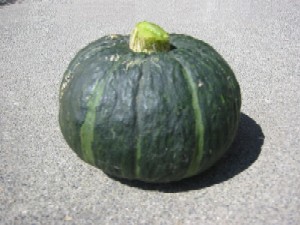
Kabocha is a type of winter squash, a Japanese variety of the species Cucurbita maxima. It is also called kabocha squash or Japanese pumpkin in North America. In Japan, "kabocha" may refer to either this squash, to the Western pumpkin, or indeed to other squashes. In Australia, "Japanese pumpkin" is a synonym of Kent pumpkin, a variety of winter squash.
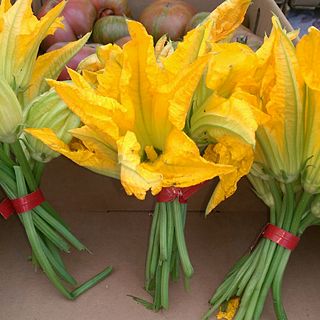
Squash blossoms are the edible flowers of Cucurbita species, particularly Cucurbita pepo, the species that produces zucchini (courgette), marrow, spaghetti squash, and many other types of squash.

Cucurbita ficifolia is a species of squash, grown for its edible seeds, fruit, and greens. It has common names including Asian pumpkin, black seed squash, chilacayote, cidra, fig-leaf gourd, and Malabar gourd. Compared to other domesticated species in its genus, investigators have noted that samples of C. ficifolia from throughout its range are relatively similar to one other in morphology and genetic composition. Variations do occur in fruit and seed color, some isozymes, and photoperiod sensitivity.

Butternut squash, known in Australia and New Zealand as butternut pumpkin or gramma, is a type of winter squash that grows on a vine. It has a sweet, nutty taste similar to that of a pumpkin. It has tan-yellow skin and orange fleshy pulp with a compartment of seeds in the blossom end. When ripe, it turns increasingly deep orange, and becomes sweeter and richer. It is a good source of fiber, vitamin C, magnesium, and potassium; and it is a source of vitamin A.

Delicata squash is a variety of winter squash with cylindrical fruits that are cream-coloured and striped in green or orange. As its name suggests, it has characteristically a delicate rind. It is also known as peanut squash, Bohemian squash, or sweet potato squash. It is a very sweet variety with a thin, edible skin and is typically cut into half rounds and roasted. It is a cultivar of the species Cucurbita pepo, which also includes the summer squash varieties pattypan squash, zucchini, and yellow crookneck squash, as well as winter squash varieties including acorn squash, spaghetti squash, and most pumpkins used as Jack-o-lanterns.

Winter squash is an annual fruit representing several squash species within the genus Cucurbita. Late-growing, less symmetrical, odd-shaped, rough or warty varieties, small to medium in size, but with long-keeping qualities and hard rinds, are usually called winter squash. They differ from summer squash in that they are harvested and eaten in the mature stage when their seeds within have matured fully and their skin has hardened into a tough rind. At this stage, most varieties of this vegetable can be stored for use during the winter. Winter squash is generally cooked before being eaten, and the skin or rind is not usually eaten as it is with summer squash.

Cucurbita maxima, one of at least five species of cultivated squash, is one of the most diverse domesticated species. This species originated in South America from the wild subspecies Cucurbita maxima subsp. andreana over 4,000 years ago. Cucurbita maxima, known for modern varieties as Hubbard, Delicious, Marblehead, Boston Marrow, and Turks Turban, originated in northern Argentina near the Andes or in certain Andean valleys. Secondary centers of diversity include India, Bangladesh, Myanmar, and the southern Appalachians.
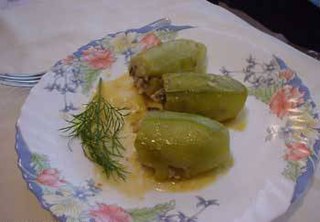
Stuffed squash, courgette, marrow, mahshi, or zucchini is a dish common in the region of the former Ottoman Empire from the Balkans to the Levant and Egypt, a kind of dolma. It consists of various kinds of squash or zucchini stuffed with rice and sometimes meat and cooked on the stovetop or in the oven. The meat version is served hot, as a main course. The meatless version is considered an "olive-oil dish" and is often eaten at room temperature or warm.

A pumpkin, in English-language vernacular, is a cultivated winter squash in the genus Cucurbita. The term is most commonly applied to round, orange-colored squash varieties, though it does not possess a scientific definition and may be used in reference to many different squashes of varied appearance.
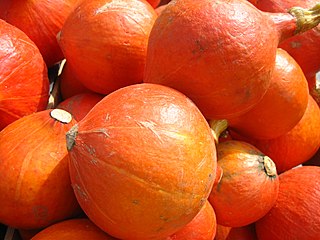
Red kuri squash is a thin skinned orange colored winter squash, a cultivated variety of the species Cucurbita maxima. It looks like a small pumpkin without the ridges. It belongs to the Hubbard squash group.
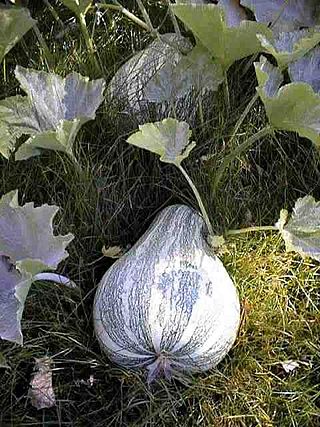
Cucurbita argyrosperma, also called the cushaw squash and silver-seed gourd, is a species of winter squash originally from the south of Mexico. This annual herbaceous plant is cultivated in the Americas for its nutritional value: its flowers, shoots, and fruits are all harvested, but it is cultivated most of all for its seeds, which are used for sauces. It was formerly known as Cucurbita mixta.

Tromboncino, also known as zucchetta, is a type of squash most often used as a summer squash. While nearly all summer squash are cultivars of Cucurbita pepo, tromboncino is a cultivar of Cucurbita moschata. The vining growth habit is similar to many winter squashes, but unlike most other summer squash. It is more tolerant to some common summer squash pests, including squash vine borer, squash bugs, and powdery mildew, than the more commonly grown, bushy, C. pepo summer squash cultivars. The plants are slower to start producing than some C. pepo types. The fruit color is usually pale green, fading to beige upon maturity, and it is picked around one foot long for summer squash. It is an heirloom, originally from Liguria, and remains popular throughout Italy and abroad. Tromboncino squash can be left to mature into a winter squash; such is often compared to a watery butternut squash. If left to ripen, the fruits can grow over three feet in length. Its flesh is delicious roasted or when prepared in a stew or soup.

This is a categorically-organized list of foods. Food is any substance consumed to provide nutritional support for the body. It is produced either by plants, animals, or fungi, and contains essential nutrients, such as carbohydrates, fats, proteins, vitamins, or minerals. The substance is ingested by an organism and assimilated by the organism's cells in an effort to produce energy, maintain life, or stimulate growth.
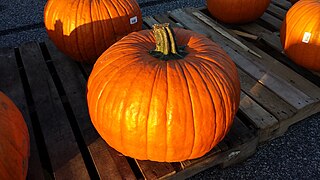
Connecticut field pumpkins are a type of pumpkin first attested in the 16th century. They are one of the oldest varieties of pumpkin in existence and are known as an heirloom plant. One of the most popular Halloween pumpkins, Connecticut field pumpkins are commonly used for autumn decorations and jack-o'-lanterns; a strain of Connecticut field pumpkins have been described as "the original commercial jack-o'-lantern pumpkin". Due to the variety's appearance and growth process, it is considered to be well-suited for ornamental use. It also has culinary uses, particularly in canning, and was used for medicinal purposes by Native Americans in the United States prior to European contact.

Honeynut squash is an interspecific hybrid winter squash cultivar bred from butternut and buttercup squash. It has dark tan to orange skin with orange fleshy pulp. When ripe, it turns from green to a deep orange and becomes sweeter and richer. Honeynut squash has a similar shape and flavor to butternut squash but averages about half the size and is sweeter. It has two to three times more beta-carotene than butternut squash. Honeynut squash can be roasted, sautéed, puréed, added to soups, stews, and braises, and has enough sugar content for desserts.



